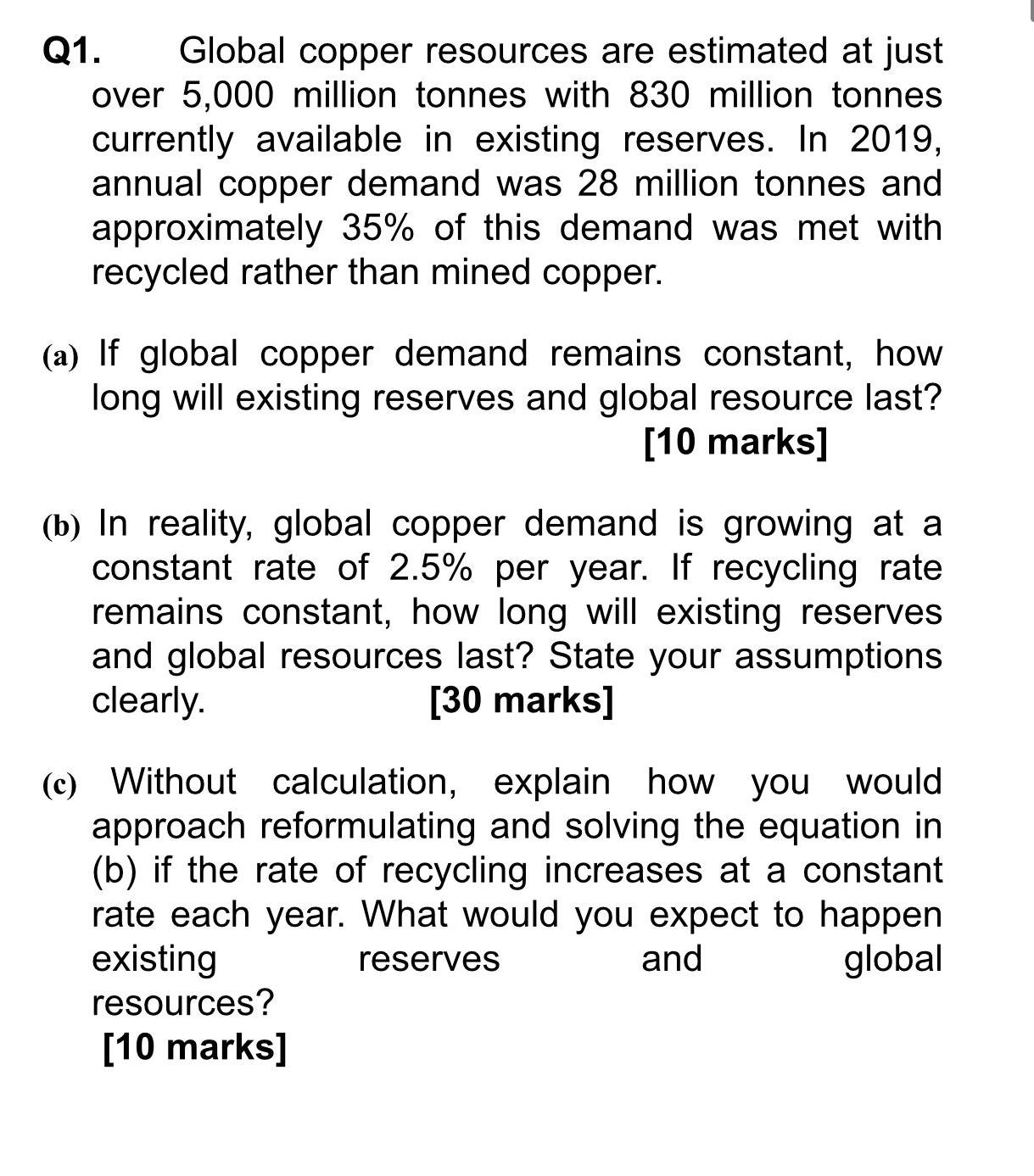Q1. Global copper resources are estimated at just over 5,000 million tonnes with 830 million tonnes...
Fantastic news! We've Found the answer you've been seeking!
Question:

Transcribed Image Text:
Q1. Global copper resources are estimated at just over 5,000 million tonnes with 830 million tonnes currently available in existing reserves. In 2019, annual copper demand was 28 million tonnes and approximately 35% of this demand was met with recycled rather than mined copper. (a) If global copper demand remains constant, how long will existing reserves and global resource last? [10 marks] (b) In reality, global copper demand is growing at a constant rate of 2.5% per year. If recycling rate remains constant, how long will existing reserves and global resources last? State your assumptions clearly. [30 marks] (c) Without calculation, explain how you would approach reformulating and solving the equation in (b) if the rate of recycling increases at a constant rate each year. What would you expect to happen existing reserves and global resources? [10 marks] Q1. Global copper resources are estimated at just over 5,000 million tonnes with 830 million tonnes currently available in existing reserves. In 2019, annual copper demand was 28 million tonnes and approximately 35% of this demand was met with recycled rather than mined copper. (a) If global copper demand remains constant, how long will existing reserves and global resource last? [10 marks] (b) In reality, global copper demand is growing at a constant rate of 2.5% per year. If recycling rate remains constant, how long will existing reserves and global resources last? State your assumptions clearly. [30 marks] (c) Without calculation, explain how you would approach reformulating and solving the equation in (b) if the rate of recycling increases at a constant rate each year. What would you expect to happen existing reserves and global resources? [10 marks]
Expert Answer:
Answer rating: 100% (QA)
a If global copper demand remains constant how long will existing reserves and global resource last 10 marks If global copper demand remains constant at 28 million tonnes per year the existing reserve... View the full answer

Posted Date:
Students also viewed these accounting questions
-
Copper Clapper Company currently has annual earnings of $10 million with 4 million shares of common stock outstanding and a market price per share of $30. In the absence of any mergers, Copper...
-
A quiz consists of 10 multiple-choice questions with 5 choices for each question. Suppose a student is sure of the first 5 answers and has each of the last 5 questions narrowed to 3 of the possible 5...
-
Find the equilibrium prices and quantities in the market for whole, roasting turkey given the information below for farm supply, retail demand, farm-to-wholesale marketing margin, and...
-
Use any method to determine if the series converges or diverges. Give reasons for your answer. n10 10" n=1
-
Determine the following standard normal (z) curve areas: a. The area under the z curve to the left of 1.75 b. The area under the z curve to the left of 20.68 c. The area under the z curve to the...
-
Using the quotations in Exhibit 7.3, calculate the face value of the open interest in the September 2010 Swiss franc futures contract. Exhibit 7.3 CME Group Currency Futures Contract Quotations...
-
Larry Bryant researches information concerning unidentified flying objects (UFOs) as the director of the Washington, DC, Office of Citizens Against UFO Secrecy, and he also writes for the monthly...
-
For each lettered space in the following table, determine the appropriate dollar amount: Total Quantity of Fixed Average Output, Cost Fixed Total Variable Variable Cost Total CostMarginal...
-
10.A positively charged particle of specific charge , accelerated by a potential difference V moves through a uniform transverse magnetic field
-
The following summarized data (amounts in millions) are taken from the September 26, 2020, and September 28, 2019, comparative financial statements of Apple Incorporated, a company that designs,...
-
Which of the following formulas properly produces the string "Income Statement"? = "Income"&" "&"Statement" =Income&Statement = "Income"&"Statement" = "Income "+"Statement"
-
Write short notes on: 1. Tolerance limits 2. Significant and non-significant variances 3. Graphic and tabular presentation of variances 4. Disposal of variances.
-
What reasons would there be for a parent to litigate under Section 504 or the ADA instead of complaining to the Department of Education?
-
By issuing US$500 million of BBBrated future exports-backed securities through an offshore special purpose vehicle (SPV), Pemex was able to lower its cost of debt by 337. 5 basis points as compared...
-
Honda shares trade on the Tokyo Stock Exchange and on the NYSE as an ADR. a. Assuming that Honda stock closed at 2,177 and that 76.55 = US$1, at what price would you expect Honda to trade on the...
-
Consider the following scenario: Jeff is a second grade student with a learning disability in reading. His individualized education program (IEP) includes direct individualized instruction in basic...
-
Summarize and explain what cyclical unemployment is and a job that may have a high rate of it? What is the formula used to calculate the unemployment rate and explain the meaning of the number?
-
Information graphics, also called infographics, are wildly popular, especially in online environments. Why do you think infographics continue to receive so much attention? How could infographics be...
-
The financial statements for the business of Jets Ski Equipment are shown below. Additional information 1. All purchases and sales of inventories are on credit. 2. On 1 July 2019, J. Waters injected...
-
Some of the most recent financial statements for Hyland Pty Ltd are shown below. Additional information 1. All purchases and sales of inventories are on credit. 2. On 1 July 2020, the shareholders...
-
The statement of cash flows for Cash4Cars Ltd follows. Ignore GST. Required (a) Explain the information that would be presented in Note 29 of Cash4Cars Ltds financial statements. (b) Explain the...

Study smarter with the SolutionInn App

